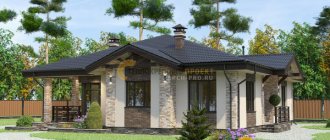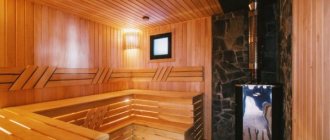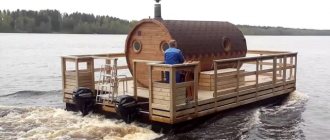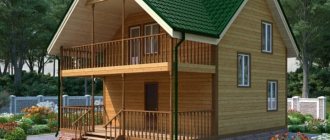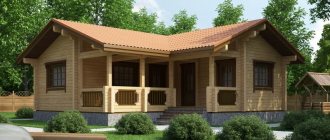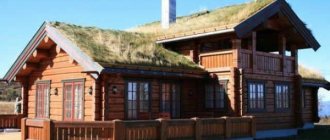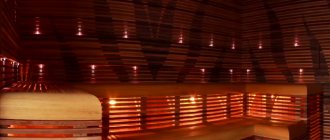When choosing how to build a bathhouse on your site in order to save money, they often stop at adding a structure to the main house. A sauna extension has a number of advantages: cost-effectiveness, ease of installation, saving space on the site. The main thing during construction is to choose the right project, taking into account all the subtleties of the extension. How to attach a bathhouse to a house, features of installation and project selection in this article. We will introduce the reader to some photos and video materials on the issue of adding a steam room to the main house.
To save space, a bathhouse extension is being built on the site.
Types of baths
Designs of bathhouses attached to the house differ depending on the type of steam room:
- Russian bathhouse with its classic attributes - a stone stove, wet steam, brooms and a font.
- Finnish sauna, in which, thanks to dry steam, you can stay in it even at a temperature of 100 degrees, but in this case the use of brooms is strictly prohibited, as they can lead to burns.
- Turkish hammam with an air temperature of about 60 degrees. You can spend a lot of time in such a steam room without harm to your health.
The choice of a bathhouse for construction depends on the personal preferences of the owner of the site.
Examples of projects
Today, there are many projects with extensions to bathhouses, thanks to which spending time becomes comfortable. The most popular option is adding a terrace with a barbecue to the bathhouse. To place a grill area on the site, the terrace must be spacious. The distance between the table and the grill is at least two meters. The barbecue is built with a chimney on a separate foundation, which must be provided for at the beginning of the project.
As a flooring for an open terrace, you need to choose sandstone or tiles. To protect from external influences of precipitation, the structure should be glazed with plastic or sliding aluminum frames. In a closed terrace, you can choose wood for laying floors.
Particular attention should be paid to the interior design of the terrace. It should be made in the same style as the steam room
We must not forget about the placement of furniture; wicker chairs and a large wooden table are ideal for the terrace.
No less popular are bathhouse designs with a relaxation room equipped with a plunge pool. The mini-pool is covered with tiles, its color and design matched to the style of the relaxation room. It is recommended to decorate the extension in an oriental style, using mosaics and floral patterns; it can be built from either wood or brick. Furniture is selected from moisture-resistant materials.
A steam room with an attached veranda will allow you to fully relax not only for all family members, but also for friends. This complex should be designed under a common glass roof and supplemented with a gazebo and a swimming pool, this will allow you to not only eat, drink tea, but also cool off in the fresh air
In order for the extensions to the steam room to look harmonious, it is important to maintain proportions in their sizes. So, for example, it is recommended to build a 2x4 m veranda for a bathhouse measuring 6x4 m; as a result, the dimensions of the combined building will be 6x6 m
In the gazebo you need to place several chairs, a bench and a table, and put comfortable sun loungers next to the pool.
If desired, the steam room can be supplemented with other extensions. It all depends on the financial capabilities of the owner of the plot and its size. Despite the fact that building extensions with your own hands is considered a difficult task, anyone can handle it. The most important thing is to draw up the project correctly and select the building material.
To learn how to build a veranda for a bathhouse with your own hands, see the following video.
How to install a bathhouse?
Is it possible to attach a bathhouse to the house? There are no legal restrictions; in addition, there are rules that regulate the construction of extensions of this type. There are several options for how you can combine a steam room with a living space:
- Using an existing wall of the house. This method is the most economical, since costs are reduced for the construction of one wall of the bathhouse. However, the savings will have to be invested in high-quality vapor barrier and waterproofing, as well as fire safety methods. It is especially important to comply with all fire safety rules if the house to which the steam room is attached is wooden.
- Bathhouse attachment to the house. In this case, the bathhouse attached to the house has its own wall, which is built close to the wall of the dwelling. The advantage of such construction is that there is no need to make a vapor barrier. In this case, the doorway connecting the two buildings turns out to be quite wide, so it makes sense to install two doors instead of one and make the one closer to the house fireproof.
- Connecting the house and the bathhouse with a short passage. In this situation, the bathhouse does not come into direct contact with the home, but it is easy to carry out all the necessary communications through the existing corridor.
The choice of method depends on the planned construction budget, personal preferences and the type of house to which the steam room is attached.
What you need to know about the foundation
Until you built the house, the soil underneath had the same properties, but the violation of its integrity, the pouring of the foundation, the load of the built house - all this changed them.
The zone within which a change in soil properties occurred does not exceed a couple of meters from the boundary of the building .
Stabilization of the soil after a house is placed on it lasts from 3 to 5 years. During this time, you should not place anything next to it, especially on a connected foundation.
Once it is established, you can build. But it is advisable that the project be carried out by specialists who can calculate how much weight the future extension will be, how much, on the one hand, it will sink the soil, and on the other hand, resist the forces of frost heaving, which tend to push the foundation out of the ground.
Of course, a lot depends on the soil itself . Some people are lucky and have sandy soil with coarse sand and gravel. And others have heaving clay, for example. Therefore, you need to know the geology of the site.
And the foundation for the extension of the bathhouse is selected according to the depth, design and material in accordance with the type of soil, the depth of groundwater, as well as the depth of soil freezing in winter. See the section on types of foundations.
ATTENTION! It is better if the groundwater is at least half a meter below the base of the foundation. If higher, then think about drainage.
This means that bathhouses are usually placed on a shallow strip foundation, but it is unlikely to be suitable for an extension to a house.
Firstly, because it is very desirable to build such a bathhouse from non-flammable material, and it weighs a lot , even if it is aerated concrete.
Secondly, because a shallow foundation is laid
above the freezing depth of the soil , and therefore, the forces of frost heaving will act more actively on it if the soil is heaving.
And it is better not to consider options for connecting the bathhouse to the house through the foundation or just the roof. Everything is fine when the foundation is laid at the same time and for both buildings at once. Therefore, it is recommended to pour the foundation immediately, taking into account all subsequent additions, if they are planned, and to implement them as funds and other opportunities become available.
If the foundations are laid at different times, and even more so at different depths, then their vibrations in the ground will not coincide in any way. It follows from this that it is best not to make a connected foundation of the house and extension.
But what's wrong with a single roof? If two foundations rise to different heights, but at the same time have a common roof, stresses will arise in the roof, which will lead to the destruction of the most stressed structural parts .
It is easier to add a bathhouse to an old house. It’s also easy to get to a house with a wide, warm blind area. In both cases, changes in the soil around the house will not have the same effect on the foundation of the bathhouse.
ADVICE! Of course, we have simplified a lot here, but the best thing you can do for yourself is to talk to specialists. So the project will be competent, the BTI will accept it, and there will be no need to expect destruction over time.
Advantages and disadvantages
The pros and cons of a bathhouse attached to a house give a person the opportunity to think about his decision about future construction. The advantages include the following:
- the opportunity to visit your own steam room without leaving home;
- reduction in costs for a separate water supply, since communications are carried out from the house;
- there is no need to go outside and be exposed to sudden temperature changes during the cold season.
However, when trying to make a bathhouse attached to a house, a person may encounter the following number of difficulties:
- compliance with all SNiPs that regulate high-quality waterproofing, vapor barrier and fire safety standards;
- engineering communications require careful calculations, as in the case of self-construction;
- the need for regular treatment of premises with antiseptics.
The majority of the disadvantages are rather arbitrary, since when building a free-standing bathhouse one would have to comply with all the same established standards.
Options for home and bathhouse under one roof
A house with a bathhouse under one roof can be built in two ways: during the initial construction of the entire complex and as an extension to an existing building.
The second option is more common, because, as a rule, many people first build a house and only then decide to use a bathhouse. When designing this way, special attention should be paid to:
Small sauna house with steam room at the entrance
- ventilation system. A bathhouse is high humidity, which contributes to the destruction of the construction site. The right design will help avoid these troubles;
- waterproofing. The room must be able to dry and ventilate. This is worth taking into account, since in the future high humidity can become a real disaster;
- where to build an extension. Experts recommend using a kitchen wall for this. With this approach, you can install a single stove, and the bathhouse will dry out much faster;
- design of wiring and sewerage systems.
Panoramic room for a steam room, with access to a common terrace with the house
When constructing a single complex, it is necessary to create unified communications. Electricity and ventilation shafts will also be part of the structure.
General recommendations
Professional builders recommend not to neglect the following tips:
- Properly done waterproofing will help to significantly extend the life of the bathhouse and the house.
- The best option is to install a stove that is designed not only for a bathhouse, but also for a home. Thus, in the summer you can dry the premises by heating, and in the winter the bathhouse will heat the house with its heat.
- It is better to attach a bathhouse made of profiled timber to a wooden house.
In general, it is recommended to build an extension in the form of a bathhouse from the same material from which the residential building is built.
Fire safety for attached baths
To protect the house from fire, a special spark arrester is installed on the chimney.
You can make it yourself or buy it in a store. The pipe is insulated on the outside using asbestos cord, and on the inside with foil insulation. It is not allowed to build a bathhouse extension where the gas pipe passes to avoid a fire in the event of a gas leak.
After completion of construction, the sauna extension must be certified by fire inspectors. If safety precautions are met, the bathhouse is ready for use.
Bathhouse made of timber
Attaching a bathhouse made of timber to a house is allowed if the entire dwelling is built of wood. To implement your plans, you will need to choose the right building material. It is recommended to use timber with a section of 150 x 150 mm. It can be made of linden, larch, cedar. It is not recommended to use coniferous trees, as they can release a certain amount of resin when heated.
The beam can be of the following types:
- Profiled sheets are convenient to use during installation; in this case, the canvas is smooth and without gaps. The disadvantages of the material include the need for additional thermal insulation cladding after some time of operation of the building.
- Glued laminated timber is often used in finished bathhouse projects. It ensures quick installation, and the foundation can be lightweight. The disadvantage is the fact that in some cases the glue may contain formaldehyde.
- Conventional timber has a relatively low cost, but can shrink and become deformed when drying.
When purchasing material, it is important to take a little as a reserve, since some part of the beams will definitely deteriorate during the construction process.
How to attach a bathhouse to a wooden house? To do this, you can use the following instructions:
- a lightweight foundation is suitable for construction - strip or pile-screw;
- mastic and two layers of roofing material are used as waterproofing of the base;
- to lay floors, it is necessary to first assemble the logs;
- building walls is not difficult, especially if you use profiled or laminated timber, in which case the materials are simply stacked on top of each other;
- doors and windows are cut out after complete shrinkage of the timber, which may take several months;
- Before the end of shrinkage, a rough roof is made; after the allotted period, it is replaced with a permanent one made of metal tiles.
A sauna made from timber turns out to be the most environmentally friendly steam room, since no harmful substances are released when the wood is heated.
Additional requirements
Just like any house projects, construction involves all sanitary and technical standards and norms, but when adding a bathhouse to a home, certain nuances arise that need to be taken into account.
Don't forget about waterproofing. After visiting the steam room, it is necessary to ensure that the room is thoroughly dried. Then the air in the bathhouse will always be hot and dry. Otherwise, high humidity will contribute to the destruction of the walls of the home.
It’s good when the bathhouse is adjacent to the kitchen so that they have a common stove. Due to this, even in summer the air will be cleaned and dried by heating. During the cold season, the bathhouse will warm the living space with its warmth. Plus, the bathhouse will be ventilated using a ventilator located under the stove.
It is better to attach a sauna to a building made of wood from profiled timber. In the case where house designs were created a long time ago, it is necessary to calculate all the nuances so that the bathhouse does not shrink.
Frame bath
Constructions of this type have recently come into use, but have managed to earn full trust among experienced builders. The undeniable advantage of a frame bathhouse - an extension to a house made of brick or wood - is the absence of the need to create complex drawings, because the building is assembled easily and simply, like a designer. In this case, the lightest and simplest foundation on piles is required. Frame baths have the following advantages:
- ease of construction;
- no shrinkage;
- ease of installation;
- thermal insulation, which is not inferior in quality to brick buildings;
- low cost of building materials.
Unfortunately, frame structures are not without flaws, but they are an order of magnitude less numerous than the positive aspects:
- increased fire hazard;
- relative fragility of the structure;
- the need for exterior and interior finishing.
It is also important to pay great attention to vapor barrier, since the materials from which the frame is made can quickly deteriorate from high humidity and temperature changes inside and outside the building. An attached frame bathhouse to a brick house can look like a single unit with a residential building if its exterior decoration is made using brick-shaped tiles.
Choosing a foundation for an attached bathhouse
You can make the foundation for the extension yourself.
It is poured as a separate mass, or joined to the main strip under the house. Separate pouring is preferable, since in its case the shrinkage of the extension will be uniform. For such a bathhouse, a lightweight strip foundation is quite suitable. The new foundation is tied to the main one using metal brackets. The joints are treated with polyurethane foam and insulated with mineral wool.
Construction stages
How to attach a bathhouse to your house? A simple rustic Russian bathhouse can be made independently if you know some basics of construction. The following stages of building construction should be followed:
- Laying the foundation is where any construction begins. It is recommended to install it taking into account the weight of the structure and the characteristics of the soil. So, for example, on moving lands it is recommended to use a pile foundation, and for the construction of a permanent brick bathhouse - a concrete, strip, reinforced foundation.
- Floor installation. Since ancient times, bathhouse floors have been made of wood. This material, although less durable than concrete, is more environmentally friendly and resistant to high temperatures. In addition, you can walk freely on a wooden floor without fear of getting burned. But builders recommend constructing logs for laying floors from asbestos-cement pipes, since they are much more durable and are not subject to rotting over time.
- The walls of the bathhouse complex can be made of logs, bricks, or made of sandwich panels. It all depends on the financial capabilities of the developer, as well as personal wishes. It should be noted that brick buildings will cost much more than similar ones made from sandwich panels.
- Metal tiles are traditionally used for roofing. This is a modern environmentally friendly material that meets all safety standards.
- The last stage is interior and exterior finishing. The outside of the bathhouse is covered with siding, a slab that imitates a log house, wild stone, and tiles with imitation brick. The interior decoration should be wooden - linden and larch wood is used for these purposes.
All stages must proceed sequentially, since this is the only way to ultimately obtain a high-quality building.
How to decide on the size
Before plunging into the exciting search for a suitable bathhouse, it is useful to decide on the area of the future purchase; This will help you immediately weed out options that are unsuitable in size and save a lot of time. The desired minimum dimensions of a bathhouse are determined by the dimensions of three rooms: locker room, washing room and steam room, taking into account the following factors:
- According to SNiP standards, one visitor should have from 3 to 4 m2 of usable space (minus the area occupied by the stove and other devices).
- The average number of visitors who will use the bathhouse at the same time is estimated.
- Tambour. An extremely necessary room that reduces heat loss and protects from drafts.
The vestibule is a room that should not be abandoned Source remont.jollow.me
If three people simultaneously enjoy bath procedures, then the minimum allowable area will be 12 m2, of which 1 m2 will be required for the vestibule, 5 m2 for the dressing room and shower room, and 5 m2 for the steam room. – 6 m2.
If you like the traditional layout of two rooms (when the locker room is combined with a relaxation room, and the steam room with a washing room), pay attention to baths 3x4 or 3x5 m. If you want to have a separate washing room (install a shower), the option with dimensions will be more comfortable 4x4 or 4x6 m
Drainage equipment
When designing and building a bathhouse attached to a house, it is important to take care of the plumbing and drainage. The advantage of such a bathhouse is that all necessary communications can be carried out from a residential building. Most often, water pipes are laid from a central water supply, but there may be several options for drainage:
- A drainage pit is considered one of the simplest and cheapest options. In this case, you just need to dig a hole of the appropriate size and line its inner walls with brick or concrete rings. A sewer truck is used to clean as it is filled.
- A drain well with a filtration system is the most expensive and labor-intensive option. The system consists of a filter made of shells, crushed stone or gravel, the upper part is filled with river silt, which is supposed to purify wastewater.
- A septic tank is a variant of a drainage pit where a plastic container for wastewater is used instead of a well. Purification can take place using a sewer truck, or a water filtration system can be installed, after which the liquid is discharged into the ground.
If the place where the bathhouse is built has a central sewer system, then you can connect the sewer pipes to it.
In addition, the floors of the bathhouse must be equipped with drains. This could be a leaking floor in a steam room, in which water passes through the cracks between the boards and collects in a tank under the floor, or concrete structures that are equipped at an angle.
What to build from: materials
Let's consider the main types of building materials that are used to attach a veranda to a bathhouse in the country.
ADVICE! It is usually recommended to build a veranda from the same wall material that was used to build the bathhouse. You can use this recommendation, or you can go against it if you decide that the veranda should be wooden, even if the bathhouse is made of blocks or bricks. And this will be an acceptable solution.
Tree
The material used by most and for most structural elements.
Thermal aspen lining. Banka Photos
Where can wood be used when adding a veranda to a bathhouse with your own hands?
Tying the foundation - for this you will need a thick beam, at least 150 mm.
Logs - the thickness of the board depends on the length of the span; the longer the logs, the thicker the board. You can use rafter boards for a large veranda.
Floorboard - depends on the type of veranda. In a closed one, you can use a regular tongue-and-groove floorboard; in an open one, it is better to use a terrace board, with a small gap that gives space for seasonal expansion of the material.
Racks - they can be not only wooden, but are often made of wood. The cross-section of the racks and their number depend on the load that the roof will transfer to them.
IMPORTANT! Do not forget to add the snow load to the weight of the roof, the data of which is taken from the reference book.
The top trim and rafter system are all parameters according to the project.
Interior finishing - if necessary, you can use regular lining.
Concrete
Concrete in the construction of a veranda can be used when creating a foundation and as a wall material, if these are blocks. We will talk about the types of foundations below.
Foundation - slab
Blocks
If the veranda is closed, then one of the wall material options could be blocks made of cellular concrete.
ATTENTION! Blocks are afraid of water, they need to be protected at least with plaster, remembering the rule of increasing vapor permeability towards the street.
The blocks also do not hold fasteners well, including making it difficult to install doors and windows.
Also, you should not make the roof too heavy if it rests on a block wall. Roof calculations are done either by specialists, or you can use one of the online calculators.
Brick
For a heavy roof, the best wall material is bricks. True, in this case everything must be solid, including the foundation.
A brick veranda goes well with a brick bathhouse. Most likely it will be a closed veranda (the option to make racks from brick and reinforcement also exists, this gives an open brick veranda). The closed version is practically an extension of another full room.
But keep in mind that you need to know the geology of the site well, make the foundation according to the geology, and consult with specialists regarding the possibility of connecting the foundation of the veranda with the foundation of the bathhouse.
Frame
A covered veranda with an insulated frame is a good budget option for increasing the area of a bathhouse. However, it is immediately worth noting that the roof should be as light as possible, because the frame is not designed for heavy roofs.
It is also worth balancing the capabilities of the frame with the weight of the glazing.
Roof features
A frame, log or brick bathhouse attached to a house must have a roof that meets all the necessary requirements. Its peculiarity is that it should not allow moisture to pass through, which will accumulate in the steam room, since it can destroy not only the bathhouse building, but also a residential building. To prevent the formation of condensation, it is necessary to carefully insulate the roof; this can be done in several ways:
- fixing the insulation directly under the rafters;
- installation of material on rafters.
It is also important to lay a layer of material under the roofing material to waterproof the room. To prevent wood rotting, all elements must be treated with resin or paint.
Project for adding a bathhouse to a house
They begin to create a project by determining how the bathhouse will be built: with a common wall, two adjacent walls, or at a distance from each other. In the latter option, they consider the construction of a connecting corridor.
The next stage is planning. Determine the number of rooms, area, purpose. On the plan, choose a place for the stove so that all compartments of the bath are heated. The diagram shows the location of wiring, ventilation ducts, and sewer system.
The foundation of the attached bathhouse is made similar to that of the house, most often a strip one. It is optimal to build both structures on the same foundation. If you are installing an extension to a finished house, it is better to pour a separate concrete strip. A more economical option is an adjacent foundation. 3 sides of the concrete strip are poured and joined to the base of the house with steel brackets. The method is economical, but due to uneven shrinkage, cracks will appear on the base and wall at the point of alignment.
The walls and roof are designed from the same material for both buildings. In addition to aesthetics, a house with an attached bathhouse will sag equally with a minimum of breaks. An extension can be erected from a different material near an old building that has experienced several years of shrinkage. The roof of the attached structure is made pitched, adjacent to the house at the top and extending under the roofing.
Internal equipment
It is not enough to know how to attach a bathhouse to a brick house; it is also important to take care of the interior decoration. The main aspects of the internal equipment are as follows:
- Doors and windows are deliberately installed smaller than the standard size - this way you can maintain the temperature inside the room.
- To ensure fire safety, all doors and windows should only open outward.
- Door handles are only allowed to be made of wood, as metal ones can cause you to get burned.
- For reasons of heat conservation, windows are positioned horizontally rather than vertically.
- All wiring in the bathhouse must be covered with a fireproof casing, and if it is located inside the walls, it must be placed in metal pipes.
- Shelves and wall trim must be made from wood species such as linden, aspen or poplar. This material dries quickly and does not release resin when heated.
- It is important not to use paints and varnishes inside the sauna, as they can release toxic substances when heated.
A bathhouse attached to a house, made of a block or other material, should be as comfortable as possible for those people who are going to use it.
Preparation of materials and tools
To build an extension, you can use different materials. Advantages of brick:
- Durability, strength, reliability.
- Attractive view. If the masonry is done by experienced builders, the seams are stitched correctly, there is no need to cladding the building.
- Immunity to temperature changes, moisture, ultraviolet radiation.
- Resistant to mold and mildew.
Flaws:
- Large mass. Brick buildings require a massive base - strip or monolithic.
- High price.
Advantages of foam block:
- low price;
- low specific gravity;
- ease of installation;
- high thermal insulation.
Flaws:
For blocks you need to do additional decorative finishing inside and outside. It is important to make high-quality waterproofing, since foam blocks quickly become saturated with moisture and begin to collapse. You need to work with blocks carefully, as they crumble when hit.
Advantages of wood:
- Environmentally friendly.
- Attractive view. Wooden surfaces do not require decorative finishing.
- Low thermal conductivity.
Flaws:
- Wood is destroyed by moisture. Therefore, the material must be impregnated with antiseptics.
- A log house made from undried wood takes a long time to dry out. You need to wait about a year before decorative finishing, installation of windows and doors.
Tools and equipment for building an extension:
- bayonet, shovel;
- manual concrete mixer;
- grinder, drill with drills;
- screwdriver, grinder;
- welding machine;
- a set of files, chisels;
- hammer, metal brush;
- chainsaw, hand hacksaw;
- miter saw, jigsaw.
You will also need basic consumables, fittings, metal sheets, hydro, steam and thermal insulation, plastic pipes, corrugation, wires, boards, bars, slats, roofing material.
Bath accessories
It is difficult to imagine a steam room without traditional accessories - brooms, ladles, water buckets. It is also important to follow safety precautions. Buckets and buckets should only be made of wood to avoid getting burned when using them. But the brooms can be anything - juniper, oak, birch, linden, maple, alder, herbal (mint, nettle, wormwood).
What are the difficulties?
- First of all, the difficulty of combining two walls. Most projects include a connecting insert between structures; it hides the junction.
- The second difficulty is the quality of the foundation. To prevent detachment during possible shrinkage, a foundation is made that matches the main brick building.
- The third criterion is the presence of a separate pipe and sewer pit, so as not to overload the general sewer system. You should also think about fire safety and good ventilation, because a fire in the steam room is transferred to housing.
conclusions
Brick is an excellent material for a bathhouse. The main advantage over traditional wood for a bathhouse is fire resistance and durability. This is the main thing that needs to be taken into account in the construction of a brick bathhouse, although the construction itself will be more expensive than for a wooden one, but these additional costs will pay off over the years of operation.
The second important conclusion is that a brick bathhouse needs to be very well insulated. Brick has been known as a building material for a long time, but it began to be used for baths only with the advent of good modern insulation materials. You can improve the performance of brick walls by using special hollow bricks.
Using a standard project allows you to insure yourself against construction errors, inconvenient layouts, incorrect insulation schemes and many other shortcomings.
